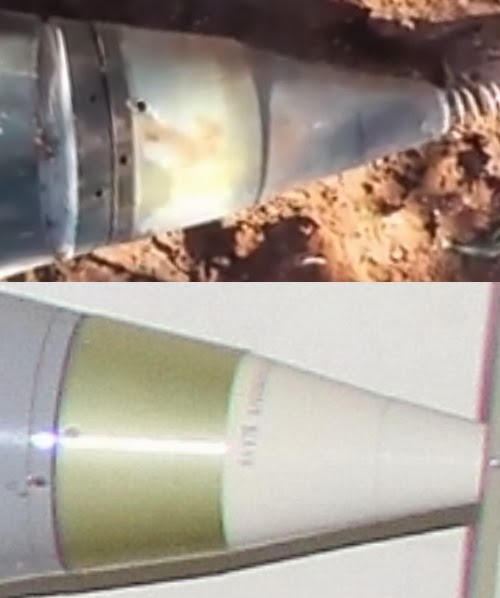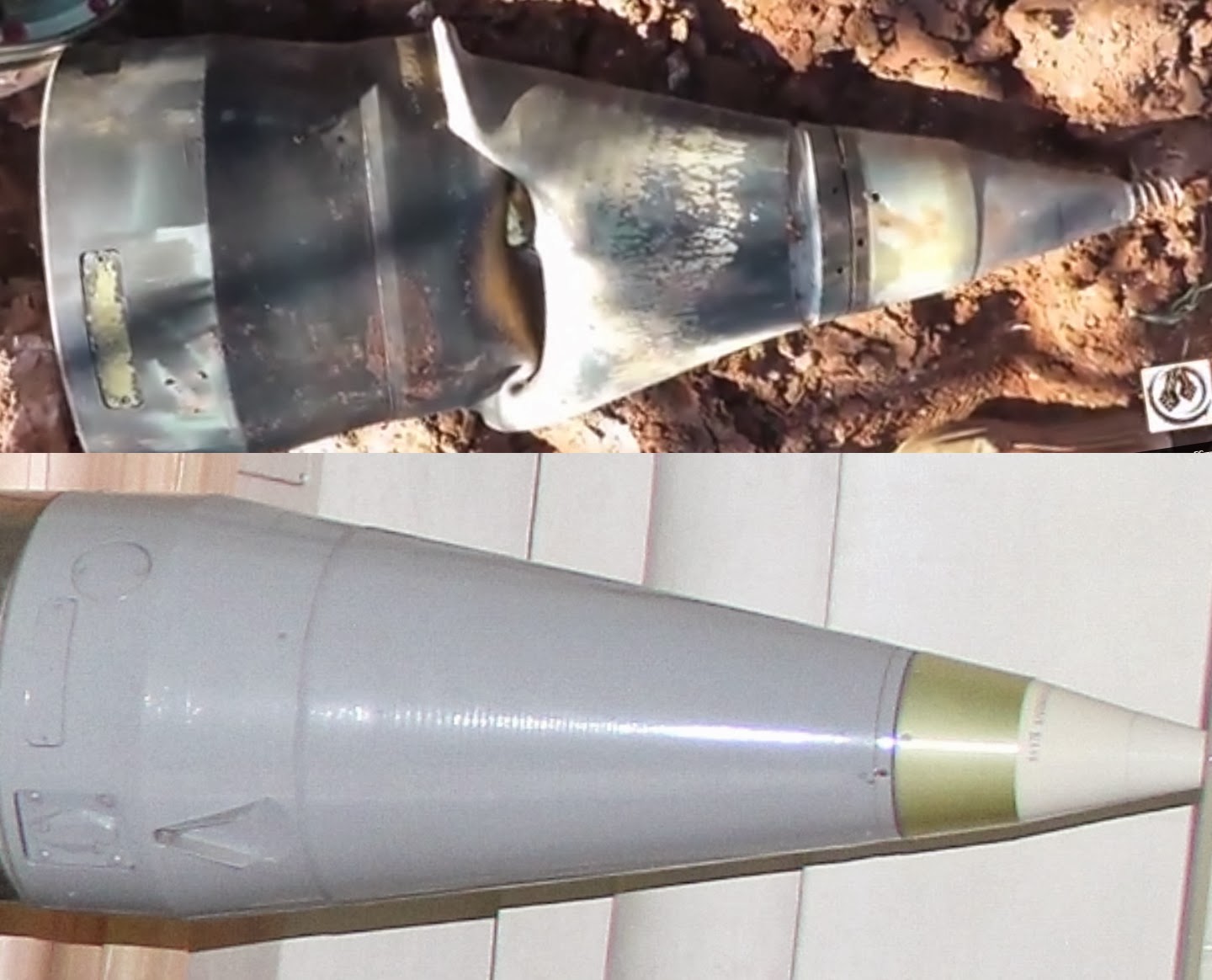On February 12th 2014, the following video from Kafr Zita, Hama, was uploaded to YouTube, showing what was claimed to be the remains of a cluster munition
The munition has broken into two sections, the first section is shown below, in an image stitched together from two video stills
The nose cone section is shown below
The remains of the rocket were much larger than any air-dropped cluster munitions used by the Syrian air force, so I took at a look at the multiple rocket launchers used by the Syrian military. The BM-27 Uragan is the largest multiple rocket launcher system I could find that open source information suggested was being used by the Syrian military, but the 220mm calibre of the rockets seemed far too small for what was seen in the above images. I compared the foot in the top left corner of the above image to the width of the rocket, and from that it was clear the rocket was closer to 27-30cm wide than the BM-27's 22cm calibre.
I reviewed large rocket systems, and from my investigations it appears the best match is the BM-30 Smerch, a Soviet multiple rocket launcher system, which entered service in the Soviet Army in 1989. It launches several types of rockets, including cluster munitions designated 9M55K, 9M55K1, and 9M55K4. While there's not a great amount of detail on the rockets online, I did come across the following image (source)
This shows the 9M55K rocket on the top, and the 9M55F (high explosive fragmentation) rocket on the bottom. They share a number of design features, some of which I've highlighted below
Based on this, and other images, it seems certain the remains of the rocket in the video is from the 9M55K range of cluster munition rockets, launched by the BM-30 Smerch. While there's no open source information that suggests the Syrian military has this system, it seems unlikely that the rocket could have come from any other source. With a range of 90km, it not possible to know what the point of origin was, but it does appear to be the first evidence that the Syrian military are using BM-30 Smerch multiple rocket launchers in the conflict.
Thank to Chris Kabusk for help with this article.
Also thanks to Bente Aika Scheller, author of The Wisdom of Syria's Waiting Game. Foreign Policy under the Assads, whose donation to last years Indiegogo campaign helped keep this blog going.
You can contact the author on Twitter @brown_moses or by email at brownmoses@gmail.com.
The munition has broken into two sections, the first section is shown below, in an image stitched together from two video stills
The nose cone section is shown below
The remains of the rocket were much larger than any air-dropped cluster munitions used by the Syrian air force, so I took at a look at the multiple rocket launchers used by the Syrian military. The BM-27 Uragan is the largest multiple rocket launcher system I could find that open source information suggested was being used by the Syrian military, but the 220mm calibre of the rockets seemed far too small for what was seen in the above images. I compared the foot in the top left corner of the above image to the width of the rocket, and from that it was clear the rocket was closer to 27-30cm wide than the BM-27's 22cm calibre.
I reviewed large rocket systems, and from my investigations it appears the best match is the BM-30 Smerch, a Soviet multiple rocket launcher system, which entered service in the Soviet Army in 1989. It launches several types of rockets, including cluster munitions designated 9M55K, 9M55K1, and 9M55K4. While there's not a great amount of detail on the rockets online, I did come across the following image (source)
This shows the 9M55K rocket on the top, and the 9M55F (high explosive fragmentation) rocket on the bottom. They share a number of design features, some of which I've highlighted below
Based on this, and other images, it seems certain the remains of the rocket in the video is from the 9M55K range of cluster munition rockets, launched by the BM-30 Smerch. While there's no open source information that suggests the Syrian military has this system, it seems unlikely that the rocket could have come from any other source. With a range of 90km, it not possible to know what the point of origin was, but it does appear to be the first evidence that the Syrian military are using BM-30 Smerch multiple rocket launchers in the conflict.
Thank to Chris Kabusk for help with this article.
Also thanks to Bente Aika Scheller, author of The Wisdom of Syria's Waiting Game. Foreign Policy under the Assads, whose donation to last years Indiegogo campaign helped keep this blog going.
You can contact the author on Twitter @brown_moses or by email at brownmoses@gmail.com.






